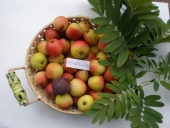Hello Judith and Miles,
Now that I know that it is neither difficult nor expensive to send post to the US, I will resend some seeds in next fall.
In fact I am terribly sorry. I did exactly the same as you did, with exactly the same seeds that were "stratified" inside the fruits on my balcony during last winter. I planted the seeds on April 7th. And as of today I have nothing. I am really confused about this. I thought that it would work, and it seems that it is a failure

To see pictures of the seedlings in order to recognize them, once again a good place is instagram.
Here the seeds just germinated, some seedlings still have the 2 cotyledons covered by the hard brown skin of the seed :
https://www.instagram.com/p/BxRiJsKACfZ/
Here you still see the 2 round shaped cotyledons and the first 2 leaves in a state maybe 2 weeks after above:
https://www.instagram.com/p/BvrhwGDBy-1/
And here the same one month later :
https://www.instagram.com/p/BxBDK8kg3WA/
In this state they are VERY fragile. They only begin to build wood in the middle of the summer.
After 4 years it is still difficult for me to choose when exactly to repot them. 2 years ago after I discovered that in fact one should use pure sand, I did not repot 4 of them and left them in the sand until next winter. Strangely it did not harm, they survived.
Thus nowadays, if I had enough space, I would collect plastic bottles (it is free and so they would not end in the see...), cut off the top, drill small holes underneath, fill up half with ground at the bottom and half with sand at the top, put 1 or 2 or max 3 seeds into the sand, not very deep, and forget them in a cool place during the winter (should not become too dry of course). This way it would not be necessary to manipulate the seedlings during 1 or even 2 years, until they would be strong enough. But this means having quite a lot of space, or do only a very limited quantity...













